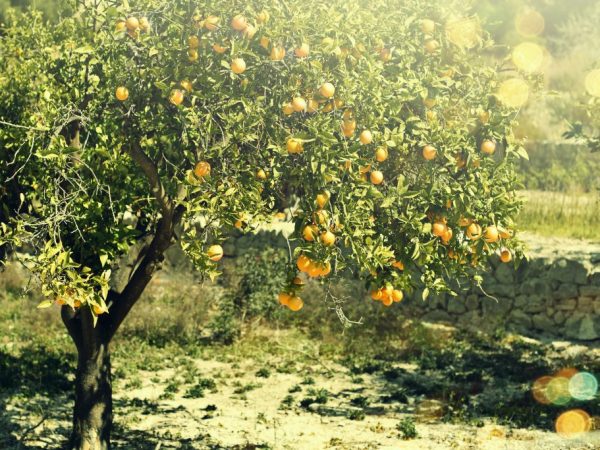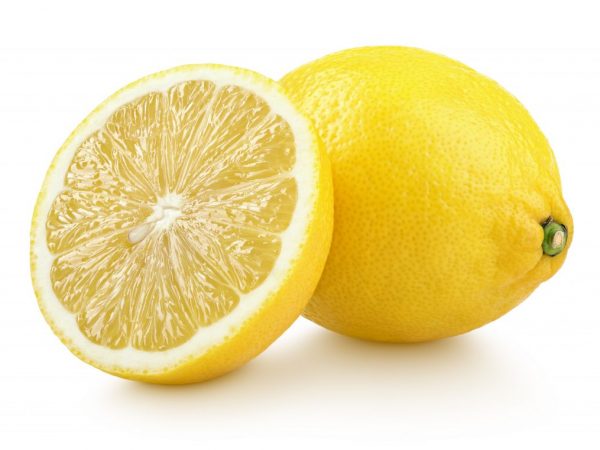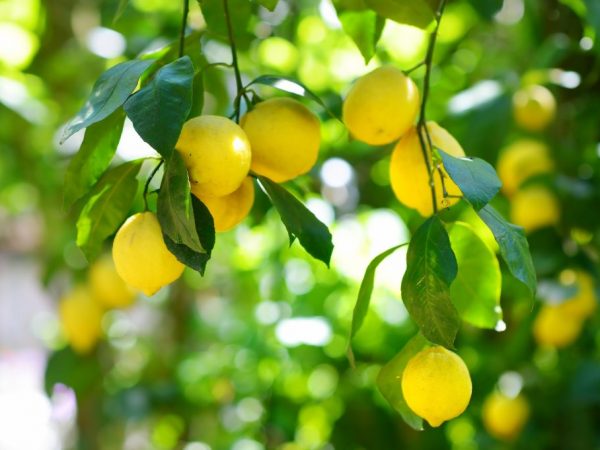Lemon tree
Lemon is an evergreen tree that grows in the tropics and subtropics. It has been cultivated for several millennia. The crop is often grown in greenhouses or at home. The fruits have an elongated shape, a yellow fragrant skin and sour pulp, have useful properties, are widely used in cooking.

Lemon tree
Lemon origin
The lemon tree belongs to the Rutov family, the Citrus genus. The fruit is a hybrid of lime and etrog. Most likely, the crossing happened naturally. Wild lemons are found naturally in the mountainous plateaus of India, Myanmar and China. Citrus comes from these countries.
In Europe, the citrus fruit has been known since ancient times. The description of this citrus is found in ancient literature and even medical treatises. It was grown in Spain, Rome, ancient Greece.
The tree has spread widely in the Middle East. In the early Middle Ages, culture almost disappeared in European countries. It was re-introduced in the X-XIII centuries by the Arabs. Lemon came to America together with the first colonizers of the New World.
Where are lemons grown now?
Currently, about 14 million tons of lemons are harvested in the world annually. The main producer is Mexico. 16% of all world production is grown here. Italy is in second place, followed by the United States and India. Lemon is grown in large quantities on the islands of the Pacific Basin, China, Southeast Asian countries, and northern Africa.
Previously, Lemon orchards occupied large areas in Azerbaijan, Georgia, Abkhazia, but now they have decreased slightly. Lemons are grown in the countries of Central Asia: in Uzbekistan, Tajikistan, Moldova. They are also supplied from Spain, Greece. At home, small decorative varieties are bred, which bear fruit and give 3-4 kg of fruit from one tree.
Description of the tree
The citrus lemon plant is an evergreen tree with a height of 3 m to 9 m. Its bark is gray, with cracks. Young shoots are smooth, covered with green or reddish-purple bark. The branches are covered with thorns, but there are species without thorns.
The leaves on the branches grow alternately. They have an elongated oval-ovoid shape, with pointed leaves on both edges. Their length is about 15-20 cm, width - 5-8 cm. The leaf plate is fleshy, with smooth solid edges, shiny top, glossy, matte bottom, rich green color. Veins are clearly visible on the plate. When viewed in the light, small pinpoint reservoirs of essential oil are visible. The leaves have a pronounced citrus aroma.
The cuttings are short, up to 1-1.8 cm in length. They are winged on young shoots, and wingless on old ones. The articulation with the leaf is well pronounced. There is an interesting fact: the leaves fall separately from the cuttings, approximately once every 3 years. This means that the structure of the lemon leaf is complex (it is in such plates that leaf fall, separate from the cuttings, is observed). In the course of evolution, there was a reduction in other parts of the leaf.
Lemon flowers are small, up to 2-4 cm in diameter, with a pronounced citrus scent. Corolla is white, with 5 petals. The outer part of the petals is colored pink or pink-purple. The buds develop over 4-5 weeks, flowering 7-9 weeks. Peak in April and May, although the flowers on the branches develop throughout the year.
Description and composition of fruits
Lemon hesperidium, or fruit, has an elongated shape. It has a large nipple at the top. Its length is 6-9 cm, diameter is 4-6 cm. The peel is light yellow, yellow or yellow-orange. It is bumpy, difficult to separate from the pulp. If you squeeze a piece of skin, essential oils begin to release abundantly. On the cut, the fruit looks like an asterisk with 8-10 rays.
Inside there are 8-10 lobules, separated by a thin film and tightly adjacent to each other. The pulp consists of dozens of small sacs filled with juice. The taste is sour, some varieties are sweet and sour. The color of the pulp is yellow or yellow-green. Inside the lobules, closer to the center, seeds with embryos are located. They are white or cream in color. There are also seedless varieties.

The fruit tastes sour
The lemon fruit ripens in September or October. At first it is green, then evenly turns yellow. Does not fall from trees, can hang on a branch for up to 2 years. During this time, changes occur in lemons. They increase in size, turn green, and then turn yellow again. At the same time, their taste is lost.
Lemon composition
Lemon fruits contain a large amount of nutrients. Brief description of its main composition (per 100 g of product):
- proteins - 0.9 g;
- fats - 0.1 g;
- carbohydrates with monosaccharides and disaccharides - 4.9 g;
- fiber or dietary fiber - 1.3 g;
- pectin - 0.5 g;
- organic acids - 5.7 g;
- ash or dry minerals - 0.5 g;
- calorie content - 33 kcal.
Lemon contains almost half the daily dose of ascorbic acid required for humans - 40 mg per 100 g. The fruit is rich in carotene, it contains vitamins B1 and B2, folic acid, niacin or vitamin PP. Citrus contains a lot of potassium, about 160 mg. It is rich in iron, therefore the fruits are recommended to be eaten in case of anemia. Also in lemons there is calcium with phosphorus, which have a positive effect on the skeletal system. Of the trace elements in the fruit, most of all are copper, zinc, manganese.
In addition, the composition includes coumarins, galacturonic acid. There are 3 times less sugar in the pulp than in oranges, 4 times less than in tangerines and 2.5 times less than in grapefruits. In terms of vitamin C content, this fruit is superior to other citrus fruits. No wonder it was used to treat scurvy.
The benefits of lemon
The beneficial properties of lemon have been known for a long time. There are even myths around the fruit. For example, in ancient Rome it was believed that it saves from poisons. In the Middle Ages, it was recommended to prevent the plague. Reality has shown that citrus is powerless against this terrible disease.
Today, the following beneficial properties of the yellow sour fruit have been proven:
- Vitamin C and flavonoids improve immunity, strengthen blood vessels, and help fight infections. Ascorbic acid reduces the harmful effects of free radicals, prevents aging and cancer.
- The juice stimulates the liver, helps to quickly neutralize toxic substances, and thins bile.
- Strengthens intestinal motility, eliminates constipation.
- Helps dissolve stones in the gallbladder and kidneys.
- The substance tangeretin, which is in the peel, improves the functioning of the nervous system, reduces the symptoms of Parkinson's disease.
- Juice and zest regulate the work of the sebaceous glands, reduce the oiliness of the hair, essential oils strengthen them and stimulate growth.
- Lemon is used as an effective remedy for worms.
- The juice and essential oils of the peel have antiseptic properties, they treat wounds, scratches on the skin.
- Vitamin P strengthens blood vessels, stops bleeding gums.
- Rutin improves vision, relieves signs of diabetic retinopathy.
- Face masks from the pulp and peel of citrus fruit eliminate acne, oily sheen, and normalize the function of the sebaceous glands of the skin.
- A decoction of the leaves lowers the temperature, relieves pain.
Lemon is contraindicated for stomach ulcers, high acidity, chronic pancreatitis, acute gastritis and enteritis.
Conditions for growing lemon
Lemons are grown in different ways. Planting in open ground or in trenches is of industrial importance. Less commonly in regions with cold winters. Trees are cultivated in a half greenhouse way, for the winter they are covered with foil, reed mats. It is convenient to grow lemons in greenhouses, but such fruits are not sold for sale. Small decorative trees are planted in tubs, kept in apartments or on balconies.
The tree prefers soil with a pH close to neutral. The soil should be nutritious, organic, well fertilized and loose. Lemon roots are not too long, so they are not able to take moisture from deep sources. The tree needs regular watering with settled water. For example, in the arid regions of Uzbekistan, plants are watered up to 32 times a year. Even in the humid mountain valleys of Azerbaijan, the bushes are moistened 4-5 times a year.

The tree needs regular watering
Trees have low frost resistance, but it does not like high temperatures either. The intensive growth of lemons begins when the air warms up to 9 ° C-10 ° C, and on the surface of the soil at this time, 17 ° C-18 ° C has already been established. The optimum temperature for plant development and fruit ripening is 20 ° C-21 ° C. Lemon roots and its crown freeze at sub-zero temperatures, even -3 ° -4 ° C are dangerous for them. At -8 ° C or -9 ° C, the bushes die. Frost resistance of trench crops is even lower.
Lemons are not so demanding for lighting. They grow quietly in shaded areas, in the middle of other trees.
When growing, they must form a crown so that the tree does not stretch above 3-4 m. There are also undersized varieties, some of them spread along the ground, so they are tied to supports.
Reproduction and cultivation at home.
Most lemons are propagated by cuttings or by grafting onto another citrus tree. Growing from seed leads to a loss of varietal qualities. The seed sprouts for several months. Homemade lemon is also best propagated by cuttings. To do this, take a twig with 3-4 leaves and put it in water for a couple of weeks until the roots appear. The tree is planted in a spacious tub. The soil is bought in the store: special mixtures for citrus fruits are sold. Ordinary garden soil with humus will do.
Basic rules for caring for homemade lemon:
- At the bottom of the pot, make good drainage from expanded clay or crushed brick.
- The bush is watered 2 times a week, in summer - 3 times, in winter watering is reduced to 1 time.
- Leaves are wiped from time to time so that dust does not accumulate on them.
- The pot is placed on a lighted windowsill; the south, southeast or southwest side will do.
- Fertilizers are applied during the growing season, 1-2 times a month.
- In the early years, the tree is transplanted every 12 months, then every 2-3 years, as the roots grow.
- Pruning for crown formation is carried out in late winter or early spring.
With proper care, 3-4 kg of lemons are obtained from one tree. One fruit should have 10-15 leaves. If the yield is higher, the excess fruit is cut off so as not to deplete the plant.
Lemon varieties
The lemon tree has its own varieties and hybrids. Some are suitable only for open spaces, others for greenhouses, greenhouses and apartments. The most common:
- Pavlovsky. Suitable for home use. Fruits are oval, large (120-150 g), seedless, fragrant, with a thin skin. Average yield - 20-30 pcs. from a bush, up to 120 lemons ripen on old trees.
- Meyer. American hybrid of lemon and orange. The tree is not tall, up to 2.5 m. Fruits are round, with a small papilla, their skin is bright yellow, with an orange tint, thin. The taste is sweet and sour, the yield is high.The variety is cultivated both in open gardens and in greenhouses and even in apartments.
- Novogruzinsky. Street grade. Its distinctive feature is a delicate lilac shade of flowers. The fruits are elongated, of medium size, the peel is relatively thin. From one tree, 100-200 lemons are harvested per season.
- Kursk. A kind of Novogruzinsky variety. Tolerates drought and poor lighting. Fruit weight - 170-250 g, average yield. The bushes are low, up to 1.6 m.
- Joyce. A low-growing tree, does not have thorns, fruiting starts at 4-5 years. 40-50 fruits are harvested from a young bush, 120 from an old one. A distinctive feature is the delicious edible rind.
- Maikop. This is a variety for indoor cultivation, the height of the tree is up to 1.5 m. The weight of lemons is 120-150 g, up to 100 pieces are harvested from one adult tree.
- Genoa. This is an Italian low-growing variety. Fruits weigh 100-110 g, elongated, with a small nipple. The rind is sweet, without bitterness.
- Lisbon. It is a Portuguese street variety. He is considered one of the most promising. The branches of the tree are abundantly covered with thorns. The fruit has a light yellow thin rind with a good aroma. The pulp is juicy, sour and tender. One bush gives 100-150 fruits.
- Villa Franca. It is a bushy variety without thorns. It is well adapted to hot climates. The peel on fruits is of medium thickness, inside is juicy pulp with a strong citrus scent. Low yield, up to 70-80 pcs. in year.
- Panderosa, or Canadian lemon. It is a hybrid of lemon and pompelmus. A tree with shortened branches and rounded, dark green leaves. Fruits are pear-shaped or spherical, with a thick skin, weighing 500-700 g. This is the largest weight among all varieties and hybrids. The variety is suitable for growing at home.
When choosing a variety, the conditions of its cultivation, yield, fruit quality are taken into account: the thickness of the peel, the taste of the pulp, the aroma.
Interesting facts about lemons
According to legend, the lemon was first brought to Europe by the soldiers of Alexander the Great. From the Mandarin (Chinese) language, the name is translated as "fruit for mothers." Apparently in this country, citrus was believed to facilitate pregnancy and lactation.
The ancient Greeks considered lemon to be a symbol of marriage, while the Spaniards, on the contrary, a symbol of unrequited love. Jews in exile in Babylon used lemon fruit instead of etrog in Sukkot offerings. In the era of geographical discoveries, these citruses were loaded into the holds of ships, they more than once saved sailors from scurvy. The idea is credited to James Cook.
Citrus first appeared in Russia in the 17th century. At first, it was grown in the royal greenhouses, imported from Holland, served to the table of the nobility. Then the aristocrats began to plant him on the estates. Fruit became available to ordinary people only in the last century.
Everything interesting about modern lemon:
- The largest lemon orchards in the world today are located in Sicily.
- The record fruit weighed 5.265 kg, it was grown in 2003 in Israel.
- Record harvests from lemon trees - 500-600 pcs. in year.
- Unripe fruits have a dull skin, but they have a longer shelf life than fruits with a shiny skin.
- If you mix sour juice and salt, you get a cleaner for copper, steel, brass.
- If you put unripe citrus in the microwave for 20 seconds, it will come to a condition.
- To obtain 1 kg of essential oil, you need a skin of 3000 fruits.
- At aristocratic dinner parties, blueberries are always served with lemon. The berry stains the teeth, and the citrus discolours them.
Summarizing
Many people cannot imagine winter without lemons, because they replenish the supply of vitamins, make the taste of tea unique. Citruses are added to both sweet and savory dishes. Creams and sweets are made with them, fish and meat are baked, and salads are seasoned with them. Worldwide sales of lemons are growing every year.


